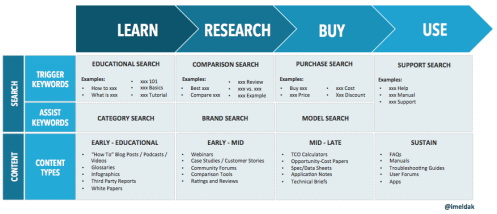Often, the hardest part about SEO is not your SEO skill set, but more the ability to apply and integrate SEO techniques into your every day marketing approach. Take content marketing as an example. “Content is king”, a commonly used (and often abused) expression, has helped to fuel a content marketing explosion, with varying degrees of quality when it comes to output. But with so much content being created, are you doing enough to ensure your content can be found?
Content audits are wonderful for showing and understanding where your content pieces fit within the buyer journey, and for identifying content gaps and opportunities. Often these audits are applied to Email nurture streams, to tell a cohesive story that helps to move prospects through the funnel. But if it isn’t taking SEO into account, particularly for those mass of unknown people who are yet to become prospects, there’s a good chance that it isn’t working as hard as it could be for you.
This is where a combined search and content mapping model can be handy. Taking a common marketing funnel approach (Learn/Research/Buy/Use) you can not only start to map out where content fits within the buyer journey, but also the types of searches that you need to consider and optimize content development for, in order for your content to get found.
The key components of the model include:
Search: Trigger Keywords
Trigger keywords provide insight into searcher intent. These are words that searchers use to narrow down their search when they have an idea of the kind of information they are looking for. Trigger words really help to provide clues to their intent, so we can better match up content that is relevant to them.
Search: Assist Keywords
Assist keywords also provide clues, but these clues are more implied through the kinds of search a person makes, as opposed to specific triggers. For example, a general category keyword search (EG: car, camera, laptop) indicates more of a discovery/educational need; versus a brand search (EG: Ford, Nikon, Apple) which can indicate more of a research need; versus a model/nomenclature search (EG: Ford Focus, Nikon Coolpix, MacBook Air) which indicates more of a purchasing need.
Content
Within this model, it starts to become clear as to how different content types align with search and the overall buyer journey. As you start to map content out, don’t forget about content that helps to support existing customers since these customers are much easier to resell to compared to acquiring new ones.
Within this, you can also start to consider specific vehicles for delivery of content. For example, YouTube is a great video vehicle for early education (learn phase). However, as people start to move more towards buying and using, videos housed on a company website can often work better due to the increased level of content control and fewer “dancing cat” distractions.



















